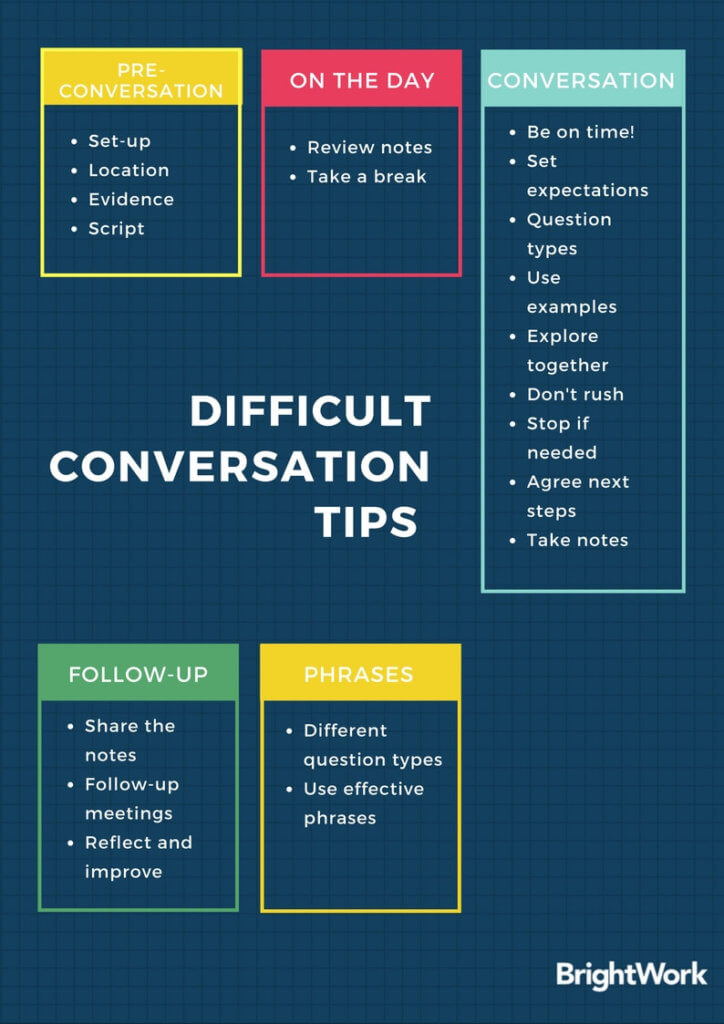Conflict, personality clashes, and other challenges will arise in project teams for many reasons. This can lead to difficult conversations between you, the project manager, and individual team members.
Learn more about different leadership styles in our free project handbook
These conversations are daunting and unpleasant but often necessary to address the situation, protect team morale, and keep the project on track. With a little practice and the right strategies, you can navigate difficult conversations to reach satisfactory outcomes.
Developing an approach to such conversations is a key step towards project leadership and should be incorporated into your communication plan.
In this article, I will outline some tips and ideas to help you prepare for and hold the conversation.
The need for difficult conversations
Conflict drains employee resources and wastes time so it is important to know when and how to tackle the situation more directly. Such situations can include:
- Sudden declines in performance and productivity.
- Inappropriate conduct toward team members or clients.
- Personal problems.
- Complaints from other team members against an individual.
- Personality clashes.
Of course, the best way to address potential issues is to prevent conflict through regular communication and interaction with your team. Watch for warning signs such as lack of engagement in meetings, missed deadlines, or any behavior that is out of character. Have an informal chat with the individual to understand the situation and decide the next steps. This may be enough to pre-empt a more formal conversation.
If you do need to discuss the issue more thoroughly, there are a few steps you can take to effectively manage the conversation.

How to Manage Difficult Conversations with Team Members
1. Pre-Conversation Tasks
Firstly, take a step back and consider if you are the right person to meet with the relevant individual. Should you ask the HR team or senior management to intervene? Check existing policies and procedures, and adhere to these guidelines. This will save time and potential headaches later on!
If you decide to go ahead, this checklist will help.
- When setting up the meeting, let the individual know why this conversation is taking place. This will give the team member a chance to prepare and avoid any sense of ‘ambush’ or confrontation on the day. A survey conducted by the Charted Management Institute revealed that 66% of workers became stressed or anxious ahead of a difficult conversation, while 11% said they suffered from nightmares or poor sleep in the build-up to a difficult work conversation. This is not a good way to start the conversation!
- Pick a neutral, private location. Ideally, you should not sit behind a desk as this creates physical and mental barriers.
- Gather evidence such as specific examples, dates, and observations about the situation.
- Loosely script the meeting. Think about how you will start the conversation, what needs to happen, and desired next steps. Run through the script a few times but don’t over-rehearse. Not only will you sound stilted, you may also struggle to adapt to the direction of the conversation.
- It is also a good idea to schedule some free time before and after the meeting so you can prepare and reflect. It is likely you will feel drained so it’s best not to have any lengthy meetings or difficult tasks to tackle straight away!
2. On the Day
- Before the meeting, review your notes and plan for the conversation.
- Get into the right headspace. Take a walk, have a coffee – whatever works for you. It is also a good idea to reframe the conversation in your head. Remember – the purpose of the meeting is to resolve a difficult or challenging situation in a positive way.
3. During the Conversation
- It goes without saying – don’t be late and put away your mobile phone and laptop!
- Start the conversation by explaining why you are meeting and what you want to get from today’s session. Maintain a professional, authentic tone and emphasize that the discussion will be confidential.
- Use different types of questions, for example, open, closed, probing and multiple. See below for a few examples.
- Refer clearly to the issue and cite any evidence or examples.
- Ask for an explanation and explore the issues together. Let the individual tell their story.
- It is important to allow for silences or pauses as the team member gathers their thoughts and considers their responses.
- Don’t play the victim. Avoid phrases such as ‘I feel so bad about saying this,’ or ‘This is really hard for me to do’.
- If the conversation becomes tricky or overly emotional, stop and adjourn to another date. The team member may need a little time and space to think about the situation.
- Agree on next steps. Don’t be afraid to make decisions – even if they are tough! As project leader, you need to resolve and contain the situation to reduce the impact on the individual, the team, and the project.
- Take notes.
4. Post-conversation
- Give a copy of agreed next steps to the employee along with any supporting material and a summary of the consequences if the agreement is not met.
- Depending on the agreed resolution, you may need to set-up additional meetings and check-ins.
- Reflect on how you handled the conversation and identify any areas for improvement
Useful phrases and questions
One way to control the conversation is to choose effective phrases and questions.
There are different types of questions you can use to start, maintain, and close the conversation:
- Open questions allow the other person to talk freely. These often start with who, where, what, why, when or how, for example, ‘how do you feel about?’
- Closed questions are a useful way to gain very particular information, for example, how long did it take?
- Probing questions provide an opportunity to get more details. These include ‘why did you say that?’ and ‘how did you feel about?’
- Leading questions should be avoided as you risk forcing your own opinion on the individual. ‘’You must admit that’ is an example of a leading question.
Words have an immense power to create empathy or bring up barriers. A few well-placed phrases can really make the difference in resolving the situation:
- ‘I want to be completely transparent with you’: This indicates openness, friendship, and a shared level of experience
- ‘I wonder if’: You don’t’ have all of the answers and want to propose a solution that may receive negative feedback.
- ‘How do you feel about that?’: This demonstrates that you care about the other person and are giving them an opportunity to express themselves.
- ‘That’s a really good observation & I would like to think about it a little more’: Use this response if you need more time to make a decision.
- ‘I don’t have the answer right now’: A little honesty goes a long way!
- ‘Why don’t we work together?’: This gives the other individual some control, and can also get a conversation back on track.
- ‘It’s difficult to’: Use strategically to overcome confrontational tones.
- ‘Were you aware?’: Make sure the individual is familiar with policies and procedures etc. Tip: avoid ‘Did you know’ as this can make the other person feel incompetent.
- ‘That is different from’: Acknowledge this is a new situation and requires a different solution than the experiences of other team members.
- ‘How might [problem] be solved?’: Focus on the future to keep the conversation positive.
Conclusion
Research demonstrates that most people would do anything to avoid a difficult conversation and would rather put up with negative situations than talk about it. If only resolving these situations was so simple! As a project leader, you need to define appropriate behaviors and address negative situations as they arise.
Your team will be happier, which will lead to a more successful project.

